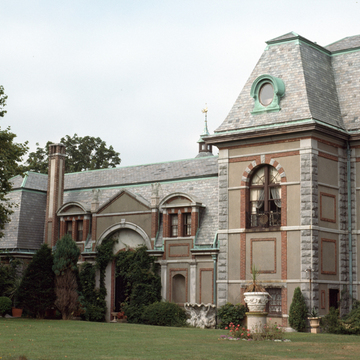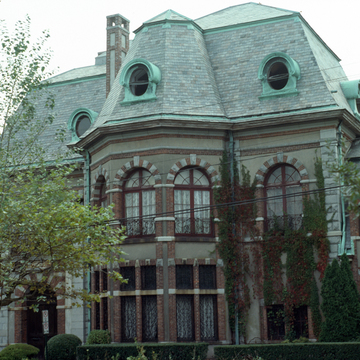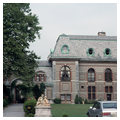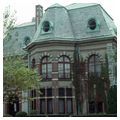You are here
Oliver Hazard Perry House (Belcourt)
Alva Smith Vanderbilt probably has the distinction of being the only Newporter to have resided in two of her own Bellevue Avenue mansions, first with her husband, William Kissam Vanderbilt, in Marble House and then, following their divorce, across the way at Belcourt, which Oliver Hazard Perry had given to her as a wedding present in 1896. Often considered one of the most visually striking of Newport's large houses, Belcourt was designed by Richard Morris Hunt with medieval references throughout, so today it is sometimes nicknamed Belcourt Castle. Part of its originality lies in Hunt's idiosyncratic combination, representing aspects of two early designs for the house, of English half timbering with French-style masonry work. Here, in one of his last works, Hunt returned at least partially to the picturesque wood-frame imagery of his earliest projects, such as the Griswold House, of the 1860s (see entry for Newport Art Museum, above).
Toward the southern end of the Bellevue elevation, an arched gateway leads to a compressed garden court, all but overwhelmed by the scale of the half-timbered residential wing to the north and the lower, turreted stable and service wing to the south. Much of the first story of the main wing is taken up by immense and elegantly furnished stables, with living quarters and a Gothic-vaulted ballroom for baronial entertaining of up to 300 guests. This
The steep slope of mansard roofs punctuated by copper-framed circular dormer windows tops Hunt's masonry walls. Heavy, rusticated granite quoining, arched brick door and window surrounds, and iron grillwork—an unexpected range of materials and textures, not always successfully unified—leave an unresolved but lasting impression. The exterior currently shows need of restoration.
Writing Credits
If SAH Archipedia has been useful to you, please consider supporting it.
SAH Archipedia tells the story of the United States through its buildings, landscapes, and cities. This freely available resource empowers the public with authoritative knowledge that deepens their understanding and appreciation of the built environment. But the Society of Architectural Historians, which created SAH Archipedia with University of Virginia Press, needs your support to maintain the high-caliber research, writing, photography, cartography, editing, design, and programming that make SAH Archipedia a trusted online resource available to all who value the history of place, heritage tourism, and learning.





















